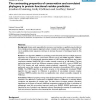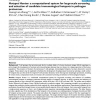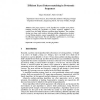21 search results - page 4 / 5 » Neural Networks for Determining Protein Specificity and Mult... |
BMCBI
2008
13 years 6 months ago
2008
Background: Amino acids responsible for structure, core function or specificity may be inferred from multiple protein sequence alignments where a limited set of residue types are ...
BMCBI
2008
13 years 6 months ago
2008
Background: T-cell epitopes that promiscuously bind to multiple alleles of a human leukocyte antigen (HLA) supertype are prime targets for development of vaccines and immunotherap...
IWANN
2009
Springer
14 years 25 days ago
2009
Springer
Abstract. This paper proposes a novel algorithm for complete exact patternmatching focusing the specificities of protein sequences (alphabet of 20 symbols) but, also highly efficie...
BMCBI
2002
13 years 6 months ago
2002
Background: Most profile and motif databases strive to classify protein sequences into a broad spectrum of protein families. The next step of such database studies should include ...
WABI
2010
Springer
13 years 4 months ago
2010
Springer
Quantification of selective pressures on regulatory sequences is a central question in studying the evolution of gene regulatory networks. Previous methods focus primarily on sing...



